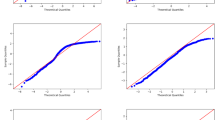Abstract
A model for intraday stock price movements is considered. The jump-intensity of the logreturn process is a function of the whole history of a hidden marked point process. The aim is to find the conditional law of such intensity given the history of the logreturn process. Under a Markovianity assumption, related with the weak form of market efficiency, classical filtering techniques are used. The law of the jump-intensity, given the history of the logreturn price, is evaluated and a discussion on a particular case is performed.
Similar content being viewed by others
References
Arjas, E., Haara, P., Norros, I.: Filtering the histories of a partially observed marked point process. Stochastic Process. Appl. 40, 225–250 (1992)
Brémaud, P.: Point Processes and Queues. Springer-Verlag, (1980)
Calzolari, A., Nappo, G.: The Filtering Problem in a Model with Grouped Data and Counting Observation Times. Preprint (2001), www.mat.uniroma1.it/people/nappo/nappo.html
Ceci, C., Gerardi, A.: Partially observed control of a markov jump process with counting observations: Equivalence with the separated problem. Stoch. Process. Appl. 78, 245–260 (1998)
Ceci, C., Gerardi, A.: Filtering of a markov jump process with counting observations. Appl. Math. Optim. 42, 1–18 (2000)
Ceci, C., Gerardi, A.: Nonlinear filtering equation of a jump process with counting observations. Acta Appl. Math. 66, 139–154 (2001)
Centanni, S., Minozzo, M.: Estimation and Filtering by Reversible Jump MCMC for a Doubly Stochastic Poisson Model for Ultra-high-frequency Data. Statistical Modelling, Arnold Journals, London, p. 20 (2004)
Ethier, S.N., Kurtz, T.G.: Markov Processes: Characterization and Convergence. J. Wiley, New York (1986)
Frey, R.: Risk minimization with incomplete information in a model for high frequency data. Math. Financ. 10(2), (2000)
Frey, R., Runggaldier, W.J.: A nonlinear filtering approach to volatility estimation with a view towards high frequency data. Int. J. Theor. Appl. Financ. 4, (2001)
Kliemann, W., Koch, G., Marchetti, F.: On the unnormalized solution of the filtering problem with counting process observations. IEEE Trans. Inf. Theory 36(6), 1415–1425 (1990)
Kurtz, T.G., Ocone, D.: Unique characterization of conditional distributions in nonlinear filtering. Ann. Probab. 16, 80–107 (1988)
Nappo, G.: Private communication (1998)
Rogers, L.C.G., Zane, O.: Designing models for high frequency data. Preprint University of Bath (1998)
Zeng, Y.: A partially observed model for micromovements of asset prices with bayes estimation via filtering. Math. Financ. 13(3) (2003)
Author information
Authors and Affiliations
Corresponding author
Rights and permissions
About this article
Cite this article
Gerardi, A., Tardelli, P. Filtering on a Partially Observed Ultra-High-Frequency Data Model. Acta Appl Math 91, 193–205 (2006). https://doi.org/10.1007/s10440-006-9038-1
Received:
Accepted:
Published:
Issue Date:
DOI: https://doi.org/10.1007/s10440-006-9038-1




